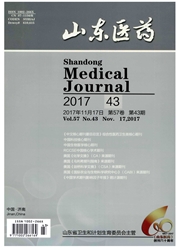

 中文摘要:
中文摘要:
①目的探讨血管内皮祖细胞(EPC)对脓毒症小鼠重要器官的保护作用。②方法首先取6-8周龄的C57BL背景绿色转基因小鼠(20只)的骨髓细胞,用密度梯度离心法获取骨髓单个核细胞,通过体外培养骨髓单个核细胞获取EPC。然后用盲肠结扎穿孔法制作小鼠脓毒症模型,并随机分为假手术组(Sham组,n=18)、模型组(CLP组,n=28)和EPC回输组(CLP+EPC组,n=28)。通过尾静脉回输EPC,观察小鼠的一般状态,通过酶联免疫吸附法测定血管内皮受损情况,并用荧光显微镜观察EPC在血管壁、肺脏、肝脏以及肾脏的聚集情况。③结果CLP组小鼠的一般情况较差,精神萎靡,活动迟缓,竖毛等,而CLP+EPC组小鼠的情况要轻。与Sham组小鼠相比,CLP组小鼠的血友病凝血因子(vWF)(49.31±0.73)、血管内皮生长因子(VEGF)(46.13±1.07)和血管紧张素-Ⅱ(Ang-Ⅱ)(13.38±0.71)明显升高(P〈0.05);与CLP组小鼠相比,CLP+EPC组小鼠的vWF(39.95±2.04)、VEGF(33.35±1.47)和Ang-Ⅱ(10.80±0.67)明显降低(P〈0.05)。荧光显微镜观察到EPC在血管壁、肺脏、肝脏和肾脏大量聚集。④结论EPC回输可以迅速聚集在血管损伤部位,对脓毒症小鼠的器官功能受损起到一定的保护作用。
 英文摘要:
英文摘要:
Objective To explore protective effect of the vascular endothelial progenitor cells on vital organs in septic mice.Methods Firstly, the vascular endothelial progenitor cells were obtained by culturing mononuclear cells in vitro, which were obtained by density gradient centrifugation from 6 to 8 weeks old C57BL transgenic mice(n =20).Then,sepsis model in mice were made by cecal ligation and puncture(CLP), and mice were dividied into sham operation group(Sham group, n = 18), the model group(CLP group, n = 28) and the endothelial progenitor cell reinfusion group (CLP+ EPC group,n =28).The vascular endothelial progenitor cells were returned through mice tail vain,ob- served the general state of mice in three groups, and the damage of vascular endothelial was detected by ELISA, then the aggregation situation of the endothelial progenitor cells in vascular wall,lung,liver and kidney were observed by using fluorescence microscopy.Results The general state of mice in CLP group was poor, listlessness,slow and piloerection, but the mice with vascular progenitor cells was better than the CLP group. Compared with the mice in Sham group, the vWF(49.31± 0.73), VEGF(46.13±1.07) and Ang-II (13.38±0.71)were increased significantly(P〈0.05)in CLP group, compared with the CLP group mice,the vWF(39.95±2.04),VEGF(33.35±1.47) and Ang-II (10.80±0.67) were significantly decreased ( P 〈0.05) in'CLP+EPC group. The vascular endothelial progenitor cells were observed in the vascular wall, lung, liver and kidney by using fluorescence microscopy.Conclusion The vascular endothelial progenitor cells can be rapidly assembled at the site of vascular injury, and play a protective role in the organ dysfunction of sepsis mice.
 同期刊论文项目
同期刊论文项目
 同项目期刊论文
同项目期刊论文
 期刊信息
期刊信息
